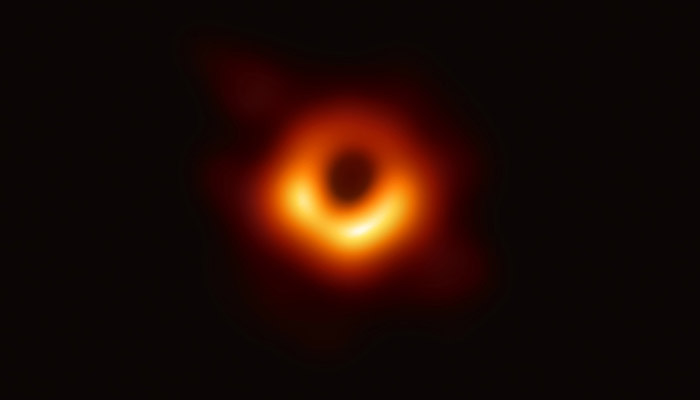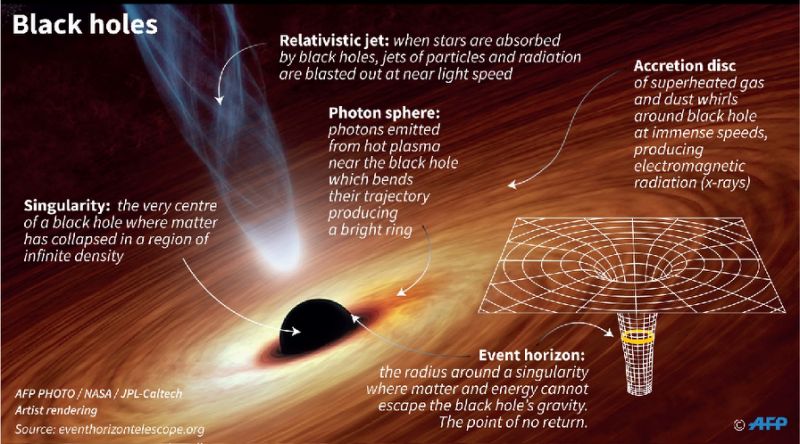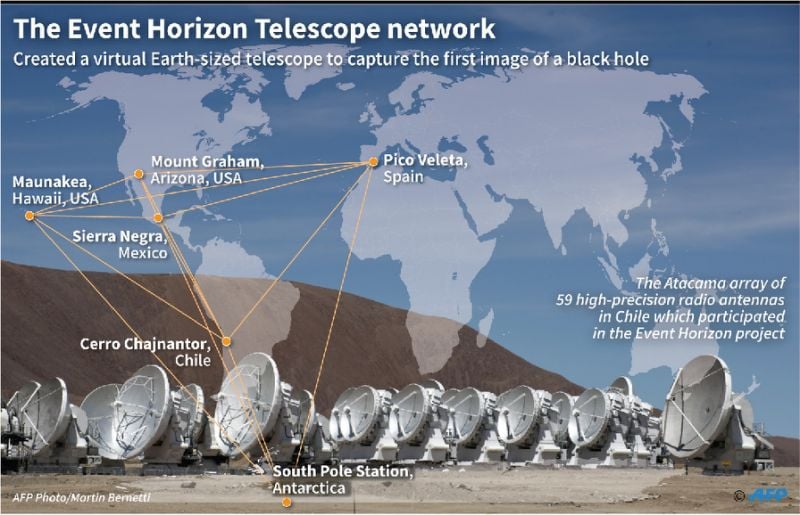Your complete guide to the black hole
Stars that get too close are flattened, shredded and transformed into swirling masses of white-hot gas by the gravitational pulls of black holes
April 11, 2019

Massive, ravenous, powerful beyond measure. Black holes are celestial objects that compress a huge mass into an extremely small space, which makes their gravitational force so strong that they swallow up everything that is too close, too slow or too small to fight it.
On Wednesday, astronomers unveiled the first photo of a black hole, one of the star-devouring monsters scattered throughout the Universe and obscured by impenetrable shields of gravity.
The image of a dark core encircled by a flame-orange halo of white-hot gas and plasma looks like any number of artists´ renderings over the last 30 years. But this time, it's the real deal.
Scientists had been puzzling over invisible "dark stars" since the 18th century, but never had one been spied by a telescope, much less photographed.
The supermassive black hole now immortalised by a far-flung network of radio telescopes is 50 million light years away in a galaxy known as M87. Over several days in April 2017, eight radio telescopes in Hawaii, Arizona, Spain, Mexico, Chile, and the South Pole zeroed in on Sag A* and M87.
Knit together "like fragments of a giant mirror," in Bremer's words, they formed a virtual observatory some 12,000 kilometres across – roughly the diameter of Earth.
In the end, M87 was more photogenic. Like a fidgety child, Sag A* was too "active" to capture a clear picture, the researchers said.
Not even light can escape
Coined in the mid-60s by American physicist John Archibald Wheeler, the term "black hole" refers to a point in space where matter is so compressed as to create a gravity field from which even light cannot escape.
The more mass, the bigger the hole.
At the same scale of compression, Earth would fit inside a water bottle cap. The Sun would measure a mere six kilometres edge-to-edge.

According to the laws of general relativity, published a century ago by Albert Einstein, the gravitational pull of these omnivorous monsters is so strong that no object can escape if it comes too close.
That includes stars and the electromagnetic waves -- no matter how long or short -- they give off, including visible light.
Black holes, in other words, are invisible.
Nor can the gravitational forces they generate be reproduced in a laboratory. If they could, it would swallow the lab and everything around it.
But scientists still know a lot about black holes because of the impact they have.
Garden-variety and supermassive
There are two kinds of black holes.
The first are garden-variety black holes that form when the centre of a very big star collapses in on itself, creating a supernova.
These can be up to 20 times more massive than the Sun, but are tiny in space.
Trying to see the one closest to Earth would be like looking for a human cell on the surface of the moon.
So-called supermassive black holes, by contrast, are at least a million times bigger than the Sun.
Point of no return
Scientists have observed these giants at the centre of every large galaxy, including our own, the Milky Way.
Supermassive black holes are thought to have first formed early in the history of the Universe.
The two black holes tracked by the Event Horizon Telescope were both of this type.
Sagittarius A* -- Sag A* for short -- is smack in the middle of the Milky Way, some 26,000 light years from Earth. Its mass is equivalent to 4.1 million Suns, and its diameter a fifth of the distance between Earth and the Sun.
The other is one of the biggest black holes known to exist -- six billion times more massive than the Sun, and 1,500 times more than Sag A*. It is located some 50 million light years from our planet, in the heart of a galaxy called M87.

The trade-off of size and distance means that -- from Earth -- both of these black holes would be roughly as easy, or hard, to detect.
Stars that get too close are flattened, shredded and transformed into swirling masses of white-hot gas by the gravitational pulls of these behemoths.
Star debris spinning around the edge of a black hole typically disappears into the darkened centre in a brilliant final flash.
"When a black hole starts to suck in mass -- which forms around it in what we call an accretion disk -- it is this mass that starts to shine," explained Paul McNamara, an astrophysicist at the European Space Agency.
So even if astronomers cannot observe the black hole itself, they see what happens along its border, or event horizon -- also known as the "point of no return".
What will happen if you fall into a black hole?
If you were to fall into a black hole, it’s not clear how you would die.
The question of how you would die inside a black hole remains one of the biggest debates in physics. Called the firewall paradox, it was brainstormed in March 2012 by a group of theorists including Donald Marolf, Ahmed Almheiri, James Sully and Joseph Polchinski.
Based on Einstein’s general theory of relativity, you would fall through the event horizon unscathed, then the force of gravity would pull you in and ultimately cram you into singularity, the black hole’s infinitely dense core.
However, here's where scientists are stuck: the presence of the firewall of the energy surrounding the black hole would violate the principles of relativity, which decreed the existence of black holes.
Stellar tombstones
Black holes are stars that have died. On July 2, 1967, a network of satellites recorded an explosion of gamma rays coming from outer space. It was one of the first indications of the existence of black holes. Scientists believe that a gamma ray burst is the final breath of a dying star and the birth of a stellar-mass black hole.
-- Additional information from the New York Times









